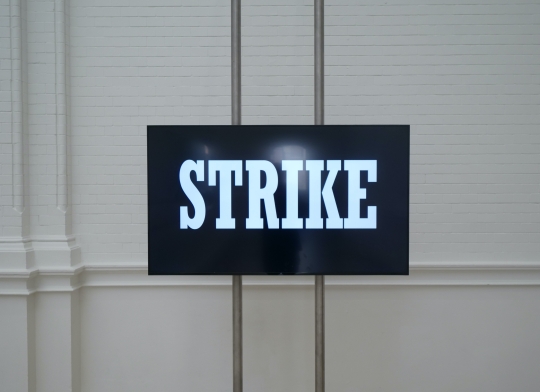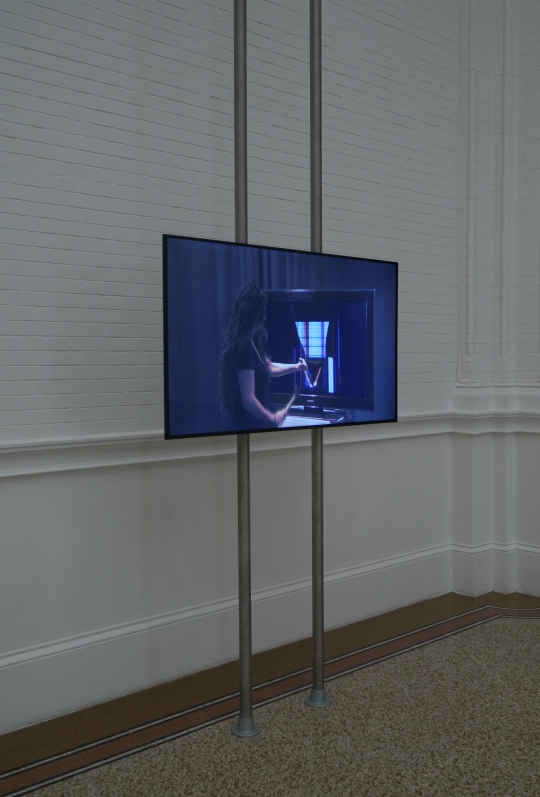
A woman, dressed in black, appears in the frame. As she strides towards the camera, we notice her image is a reflection. The video cuts to a second shot; the woman walks towards a Samsung television, set on a white pedestal, and brings out a hammer and chisel. With the chisel in her left hand and the hammer in her right, she places the chisel onto the glass of the television, her hand and the tool mirrored in its dark glass. With one accurate and controlled strike she hits the back of the chisel with the hammer: a series of horizontal and vertical lines appear on the television – forming something that resembles a corridor. The woman walks out of the frame again. Then it starts again.
A woman and a child – wearing a snakeskin patterned dress and a pink shirt – stand in front of a white room divider and next to an aquarium. Both hold a hammer in their hand. As they walk towards the camera, the woman reaches for the camera with her left hand. The lens is covered and the image becomes blurry. As soon as the image finds focus again the head of a hammer hits the lens. The only thing still visible is an out of focus light source directly in front, or above, the lens. After a brief pause the camera is hit again, the image showing dark flashes occasionally. The sound cuts off and the image becomes increasingly pixelated – until the video ends abruptly. Then it starts again.
When the video work Strike was screened in Hito Steyerl’s first retrospective, it was placed in the first room the visitor would enter. As critic Amelia Groom noted, the word “strike”, “whether it’s used in the sense of hitting something or refusing to work as a form of organized protest, implies collision, disruption, resistance.”[1] It is this sense of a double meaning of the word that Strike (2010) and Strike II (2012) play with.
In both works, the viewer is challenged to interpret the very destructive gesture they are witnessing. In the two video works Steyerl is literally striking, either the screen or the camera; hitting forcibly and deliberately – yet the damaging gesture can also be read more figuratively, as a refusal of labour. In an interview with Steyerl, for the occasion of Strike being screened on a massive monitor on the north façade of the Everson Museum of Art in New York in September of 2021, she posits the following about the relation between labour and her video work:
[I]t is more or less an archaeological gesture of revealing the matrix while destroying any sort of realistic content on the screen. So, you destroy it and you don’t: you make something else visible, which is probably the conditions of visibility. I think it becomes a slightly frantic enterprise, of a person trying to destroy a screen. But it pops back every thirty seconds, like Sisyphus.[2]The frantic enterprise that Steyerl describes, is invoked by the recurring nature of the video work: after playing for 28 seconds, it starts again. The refusal of labour in the video work, then, is the refusal of the screen and its ability to depict something, and, in Strike II, the refusal of the camera and the possibility of being depicted by it. Yet at the same time, as Groom notes, it is the Sisyphus-like character of the repetition of the work, that also sheds new light on its title: “by the time the word reappears on the screen in front of us, it might be read in the imperative form of the verb – provoking us, as bodies in front of this site of representation, to intervene with it.”
By mirroring the viewing position of the viewer watching Strike, the work also calls attention to the inherently social nature of a strike. Striking, as a form of organised protest, is something you cannot do alone. It is through making aware of the screen ‘as a screen’ that Strike figuratively proposes a ‘strike’: an active negation of the media we interact with on a daily basis.[3]
By drawing attention to these visual apparatuses and their materiality, the two video works present a way to think beyond the representational means of image media: instead of the pictorial representation of ‘what’ is on the screen, regarding the screen as a neutral medium – a transparent in-between – by striking it, Steyerl makes visible another relation; the one of the screen as an opaque surface.
In his book Rethinking Art and Visual Culture: The Poetics of Opacity, Asbjørn Grønstad theorises opacity as a response to a growing culture, and demand for transparency, visibility and legibility. Our everyday visual culture, for Grønstad, orbits around a set of implicit presuppositions:
“These assumptions and beliefs are, for instance, that the image be completely legible, that in principle anything can be visualized, that our screens will always grow incrementally brighter, and that vision and light are phenomena that are intrinsically good. (…) the medium of film has favored what could be seen as a poetics of transparency. From a technological point of view, the history of the image is the story of ever more sophisticated machines for the production of sharpness.”[4]
According to Grønstad, this regime of maximum visibility and sharpness drives both consumer and image industries. Yet there also exists a different strand of image-makers: those who work against this discourse of high definition, by seeking out low-quality, and by embracing technical imperfections. These image-makers and their images present a different aesthetic: one that is marked by “motion blur (…) grainy images, discolorations (…) glitches, and material decay.”[5] Drawing on Édouard Glissant’s conceptualization of ‘opacity’ in his book Poetics of Relation, Grønstad interprets these images as ‘opaque’ images.
Opacity, in its etymological meaning, denotes a sense of ‘darkness of meaning’, a state of being ‘impervious to light’. For Glissant – writing from a decolonial context – opacity is opposed to transparency in the sense that the latter presents a colonial, Western desire to constitute “a politics of representation that entails a modification of the identity of the other so as to be amenable to Western models.’[6] More than otherness, according to Glissant “the right to opacity”[7] has the potential to radically subvert and challenge the (post-)colonial discourse that was in place. Instead of fitting into western, phenomenological models, opacity presents an unknowability – a desire not to be legible; a refusal to be known by the very systems one is being oppressed by.
Yet the re-emergence of opacity that takes place after Steyerl strikes the screen in Strike, breaking the illusion of the screen as a transparent representational medium and consequently showing its inherent materiality, takes place on a different level than the opacity of images that Grønstad argues for.
Perhaps it can be best understood as an act of withdrawal: of placing oneself deliberately outside and in relation to the screen. In the introduction to their recently edited volume Politics of Withdrawal, Joost de Bloois and Pepita Hesselberth outline how withdrawal, although a concept seemingly signifying the a-political, apathy and disengagement, “means anything but depolitization”; to withdraw, or to negate, “does not mean retreating into passivity’” The ‘politics of withdrawal’ that is at stake in the book, is one that has a double meaning: “to withdraw means to renounce in order to reconstruct.”[8]
This is what I believe to be at the heart of both Strike and Strike II as well: when Steyerl strikes the screen, or when she hits the camera and undoes its ability to depict, she reveals these media’s opacity. As her chisel hits the screen, its (cracked) surface is made as present as its inability to display or represent anything at all. And as her hammer damages the lens of the camera, increasingly, less light becomes visible to its sensor. The material denial to be depicted on screen, or to be depicted by the camera, is a denial of being known: a desire for opacity. Yet at the same time, something else comes into existence within this moment of destruction and negation; when the screen cracks, a multitude of lines emerge. Together they form something that looks like a passageway. By revealing the virtual, or ‘the matrix’, in its own right, Strike opens up a space for contemplation on our relation to these screens in our everyday lives, and with it, the potential for withdrawal and opacity – or perhaps more radical, their destruction.
Benjamin Schoonenberg is een onderzoeker, schrijver en kunstenaar met een achtergrond in filmwetenschap, literatuurwetenschap en cultural analysis.
[1] https://www.frieze.com/article/hito-steyerl-0[2] https://www.lightwork.org/archive/hito-steyerl-strike/
[3] And in the case of Strike II the ‘strike’, or the refusal of work, can be located in the act of making the viewer aware of the camera as an actively depicting agent.
[4] Asbjø Grønstad, Rethinking Art and Visual Culture: The Poetics of Opacity, p.2.
[5] Asbjø Grønstad, Rethinking Art and Visual Culture: The Poetics of Opacity, p.3.
[6] Asbjø Grønstad, Rethinking Art and Visual Culture: The Poetics of Opacity, p.18.
[7] Édouard Glissant, Poetics of Relation, p. 190.
[8] Joost de Bloois and Pepita Hesselberth Politics of Withdrawal, p.3.
